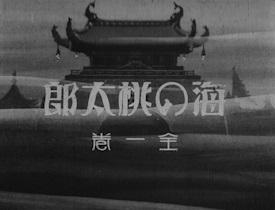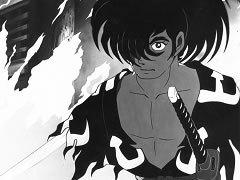Review of "Momotaro of the Sea": A tale of maritime adventure and growth

"Momotaro of the Sea": A masterpiece that marks the dawn of Japanese animation■ Public Mediatheater ■ Original MediaAnime Original ■ Release date1932 ■Frequencies16 min ■ Number of EpisodesEpisode 1 ■Original StoryChuzo Aochi ■ DirectorIllustration by Yasuji Murata ■ ProductionYokohama Cinema Company ■ Story A great commotion broke out at the bottom of the peaceful sea. The rumored giant shark came and killed all the fish. Due to this commotion, a royal conference was held in Ryugu-jo Palace, and it was decided to ask for Momotaro from Japan to help. After receiving a wireless telegram from Ryugu-jo Palace, Momotaro set off for Ryugu in his new submarine, Momotaromaru. He left the pheasant, who was weak against ships, to watch the palace, and took a dog and a monkey as servants. The giant shark lived in a cave in the coral forest, and a bomb was dropped there. The giant shark jumped out in surprise, and a great battle began. The giant shark skillfully dodged the torpedoes and went on the offensive. The ship's conning tower was destroyed, the screws were broken, and the ship lost control of the rudder. With this in mind, Momotaro himself drew his sword from his waist, straddled the giant shark's back, and stabbed it in the chest. On land, an extra newspaper was published announcing Momotaro's successful slaying of the shark, and Momotaro's parents were delighted. ■ Background and historical significance of the work"Momotaro of the Sea" is a Japanese animated film released in 1932, and has great historical significance. This work symbolizes the dawn of prewar Japanese animation, and can be said to be the crystallization of the technology and artistry of the time. Director Yasuji Murata used advanced animation technology at the time to successfully portray a realistic undersea world. In addition, Chuzo Aoji, who wrote the original story, reinterpreted a Japanese folk tale from a new perspective by transposing the traditional story of Momotaro to an undersea world. This work is an important example of the level that Japanese animation had reached before the war, and it had a great influence on later generations of animation creators. ■ Story appeal and character analysisThe story of "Momotaro of the Sea" is based on the traditional tale of Momotaro, but is set in a new setting, the undersea world. This setting is not only visually interesting, but also gives a fresh feel to the story's development. The scene in which Momotaro heads to the bottom of the sea aboard the new submarine "Momotaromaru" must have been very fresh and exciting for the audience at the time. Additionally, Momotaro's servants, the dog, monkey and pheasant, are each portrayed as unique characters, and the setting that the pheasant is particularly weak against ships is humorous and memorable. The battle scene with the giant shark is full of tension and thrills, and has a strong visual impact. The scene in which Momotaro draws his sword, straddles the shark's back, and stabs it in the chest symbolizes bravery and determination, and leaves a strong impression on the audience. The scene of Momotaro's parents rejoicing on land depicts the importance of family ties and peace, and serves as a warm conclusion to the story. ■Animation technology and artConsidering the state of the technology at the time, "Momotaro of the Sea" is an animation of extremely high quality. In order to depict the undersea world, great care was taken in the use of color and light, and the depictions of the coral forests and rock caves are particularly beautiful. The animation movements are also smooth, and the movements of the giant shark in particular are realistic and powerful. It can be said that director Murata Yasuji managed to maximize the expressiveness of the film within the limited technology available, maximizing its visual appeal. The design of the submarine "Momotaro Maru" also reflects the technology and imagination of the time, creating a perfect blend of futuristic and realistic. The bombs and torpedoes are depicted realistically, helping to heighten the tension of the battle scenes. Overall, "Momotaro of the Sea" is a technically and artistically outstanding work, and represents the pinnacle of pre-war Japanese animation. ■ Social impact and evaluation"Momotaro of the Sea" was highly praised when it was released, and had a major impact on the subsequent development of Japanese animation. In particular, the technique of reinterpreting traditional folk tales in a new setting was often seen in subsequent animation works, contributing to the diversification of the genre. In addition, the pursuit of visual appeal by depicting an undersea world can also be said to have influenced subsequent animation works. In terms of social impact, the film was accepted as a symbol of peace and courage in pre-war Japanese society. The scene in which Momotaro defeats the giant shark portrays courage and determination in the face of adversity, inspiring audiences. It can also be said to be a work that reflects the values of society as a whole by depicting the importance of family ties and peace. This work is an important example of the role played by Japanese animation before the war, and contributed to the subsequent development of animation culture. ■ Work evaluation and recommendation"Momotaro of the Sea" is a masterpiece of pre-war Japanese animation, with great historical significance and artistic value. It is an excellent work from every angle, with a compelling story, unique characters, high animation technique, and beautiful art. In particular, the technique of reinterpreting traditional folk tales in a new setting has been seen in many later animation works, contributing to the diversification of the genre. In addition, the pursuit of visual appeal by depicting an undersea world can also be said to have influenced later animation works. The reasons for recommending this work are as follows. Firstly, it has great historical significance as a work that shows the pinnacle of pre-war Japanese animation. Secondly, it has a compelling storyline, rich characters and a strong visual impact. Furthermore, it has outstanding animation techniques and beautiful art, making it very visually appealing. Finally, it has a great social impact and was highly acclaimed, and can also be commended for being accepted as a symbol of peace and courage in pre-war Japanese society. "Momotaro of the Sea" is a masterpiece of prewar Japanese animation, and its historical significance and artistic value are very high. It is an excellent work from every angle, including the appeal of the story, the individuality of the characters, the high level of animation technology, and the beauty of the art. In particular, the technique of reinterpreting traditional folk tales in a new setting was often seen in later animation works, contributing to the diversification of the genre. In addition, the pursuit of visual appeal by depicting an underwater world can also be said to have influenced later animation works. The reasons for recommending this work are as follows. First, it has very high historical significance as a work that shows the achievement of prewar Japanese animation. Second, the story is appealing, the characters are rich in individuality, and it has a strong visual impact. Furthermore, the animation technology and beauty of the art are outstanding, and it is very visually appealing. Finally, it can be appreciated for its high social impact and acclaim, and for being accepted as a symbol of peace and courage in prewar Japanese society. ■ Related works and recommendation listFor those who wish to explore the history and appeal of Japanese animation in greater depth after watching "Momotaro of the Sea," we recommend the following related works. These works are masterpieces of prewar Japanese animation, and are of great historical significance and artistic value.
■ Summary"Momotaro of the Sea" is a masterpiece of prewar Japanese animation, and its historical significance and artistic value are very high. It is an excellent work from every angle, including the appeal of the story, the individuality of the characters, the high level of animation technology, and the beauty of the art. In particular, the technique of reinterpreting traditional folk tales in a new setting was often seen in later animation works, contributing to the diversification of the genre. In addition, the pursuit of visual appeal by depicting an underwater world can also be said to have influenced later animation works. The reasons for recommending this work are as follows. First, it has very high historical significance as a work that shows the achievement of prewar Japanese animation. Second, the story is appealing, the characters are rich in individuality, and it has a strong visual impact. Furthermore, the animation technology and beauty of the art are outstanding, and it is very visually appealing. Finally, it can be appreciated for its high social impact and acclaim, and for being accepted as a symbol of peace and courage in prewar Japanese society. For those who wish to explore the history and appeal of Japanese animation in greater depth after watching "Momotaro of the Sea," we recommend the related works "Momotaro's Sea Eagle," "Momotaro: Divine Soldiers of the Sea," and "Momotaro: Demon Extermination on the Southern Island." These works are masterpieces of prewar Japanese animation and are of great historical significance and artistic value. |
<<: The Evolution of the Automobile: Evaluating the Latest Technology and Design
>>: "Suimi-bune" review: A moving story and beautiful images
Recommend
Rating and impressions of "The Rising of the Shield Hero" Season 2
The Rising of the Shield Hero Season 2 Review and...
The latest stills of the new OVA "Frozen Kizuna" of "Re:Zero" are released on November 8th
The new second OVA animation of the classic anima...
The charm and depth of Majin Tantei Nougami Neuro: A quest for the ultimate mystery and characters
Majin Tantei Nougami Neuro - The Story of a Demon...
Gundam creator Yoshiyuki Tomino's solo exhibition opens
Yoshiyuki Tomino, the famous Japanese animation d...
The movie "The Wandering of Cute Pets" released a Chinese trailer and will be released on September 18
According to new news, the movie "The Wander...
Mako-chan's Magic: A detailed review and recommendations of the fascinating anime
Magical Mako-chan - A story of a girl's growt...
Producer reveals classic American action drama "24" may have a sequel
It is reported that Fox TV in the United States i...
Asia's only Harry Potter theme park in Japan begins construction, preview of latest trailer
Warner Bros. Pictures Japan, together with giants...
The new movie version of "Mobile Police EZY" has been announced. The new trailer for the 5th anniversary will be released this summer
Compared to the "Gundam" series, which ...
Disney's famous painter passed away, his masterpieces "The Lion King" and "Mulan"
Disney officially announced the death of the famo...
A world where zombies are eaten by humans! The award-winning CG animation "Walking Meat" will be released on July 19
The Japanese dark horse CG animation "Walkin...
Tom Cruise bought two state-of-the-art robots to prevent the spread of the virus on the set of Mission: Impossible 7
The Sun reports: Tom Cruise has spent a fortune o...
Taisho Otome Otogibanashi: A thorough analysis of the beautiful historical background and moving stories
Taisho Otome Otogibanashi overview Taisho Otome O...
30,000 fans abroad launched a petition hoping Marvel can revive Iron Man
At the end of Avengers 4, Iron Man chose to sacri...
Exquisite and cool! The Colossal Titan themed ring from Attack on Titan is unveiled
Coinciding with the 10th anniversary of the seria...









